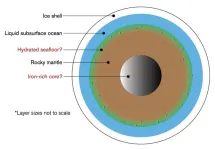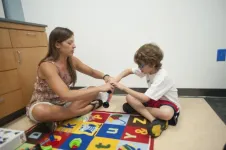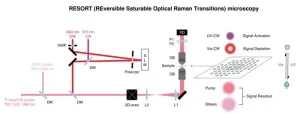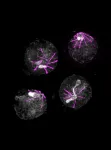(Press-News.org) Jupiter's moon, Europa, is slightly smaller than Earth’s Moon and is one of the most promising places to search for alien life.
Amid the Jovian system, Europa is of particular interest to scientists because of the strong evidence for nutrients, water and energy to potentially provide a habitable environment for some form of life beyond Earth. In addition, Europa is believed to be made up into four layers (from surface to center): an ice shell, salt water ocean, rocky mantle, and metallic core.
Like Earth, Europa’s ocean touches the rocky seafloor, which may allow for rock-water chemistry favorable for life. Some scientists also believe that the seafloor may host volcanoes, which can provide more energy and nutrients for a potential biosphere.
ASU scientists Kevin Trinh, Carver Bierson and Joe O’Rourke of the School of Earth and Space Exploration investigated the consequences of Europa forming with low initial temperatures, using computer code that Trinh wrote. Their findings have been recently published in Science Advances.
Hydrated rocks may be a key ingredient
Europa may have a metamorphic origin for the ocean. While some scientists speculated this, Trinh and his team show that if Europa indeed formed from hydrated rocks (i.e., rocks have hydrogen and oxygen), then enough of Europa’s interior should get hot enough to release water directly from the hydrated rocks to form the ocean and ice shell.
“The origin of Europa’s ocean is important because the moon’s potential to support life ultimately depends on the chemical ingredients and physical conditions during the ocean formation process,” said Kevin Trinh, graduate associate at ASU’s School Of Earth and Space Exploration.
Metallic core formation requires high temperatures
Many scientists studying this icy moon assumed that Europa formed with a metallic core during or shortly after accretion. This ASU study contradicts that prediction, instead arguing that Europa may not have started forming its metallic core until billions of years after accretion (if it happened at all).
“For most worlds in the solar system we tend to think of their internal structure as being set shortly after they finish forming. This work is very exciting because it reframes Europa as a world whose interior has been slowly evolving over its whole lifetime. This opens doors for future research to understand how these changes might be observed in the Europa we see today,” said Carver Bierson, postdoctoral research scholar at ASU’s School Of Earth and Space Exploration.
The existence of a metallic core is deeply tied to Europa’s internal heat, which may also be used to drive seafloor volcanism and contribute to a habitable seafloor environment. However, it is unclear whether Europa generated enough heat to form such a core. Trinh’s code calculates how heat is generated and distributed throughout a moon, which uses the same governing equations that many geodynamicists used for decades. The team’s novel result, however, comes from challenging the assumptions common to Europa modeling: A small moon like Europa could form as a cold mixture of ice, rock, and metal.
However, all of these processes require a hot interior. A small moon like Europa (~1% of Earth’s mass) may not have enough energy to trigger or sustain Earth-like processes—metallic core formation, seafloor volcanism, and ongoing rock-water geochemistry—which implies that Europa’s habitable potential is uncertain. The exact time at which Europa formed determines how much heat is available from the radioactive decay of a short-lived isotope of aluminum. Tidal heating (from gravitational interactions with Jupiter and other moons) also governs how quickly Europa’s interior separates into distinct layers.
Europa’s seafloor may be cool, hydrated, and experience limited (if any) seafloor volcanism
This study implies that there may be limited hydrothermal activity and seafloor volcanism at Europa, which may hinder habitability. However, confident predictions require more data.
“Europa is not just a wet, baby Earth. It is its own special world, full of mysteries to unravel,” said Joseph O’Rourke, Assistant Professor at ASU’s School of Earth and Space Exploration.
In October 2024, NASA plans to launch a spacecraft called Europa Clipper, which should arrive at Europa in April 2030. With the recent work by Trinh, Bierson and O’Rourke, scientists will be better equipped to interpret incoming data from Europa Clipper, whose main objective is to evaluate Jupiter’s icy moon Europa for the potential conditions to host life.
END
ASU study: Jupiter’s moon Europa may have had a slow evolution
2023-06-16
ELSE PRESS RELEASES FROM THIS DATE:
Adagrasib effective for patients with KRAS G12C-mutant lung cancer and untreated brain metastases
2023-06-16
HOUSTON ― Researchers from The University of Texas MD Anderson Cancer Center found the KRAS G12C inhibitor adagrasib showed promising activity suppressing cancer growth not only within the lungs but also in brain metastases for patients with KRAS G12C-mutated non-small cell lung cancer (NSCLC).
Findings from the Phase Ib cohort of the KRYSTAL-1 trial, published today in the Journal of Clinical Oncology, represent the first prospective data of anti-tumor activity from a KRAS G12C inhibitor in brain metastases, providing continued evidence of the ...
ACQUIRE therapy framework shows results for intensive pediatric rehabilitation
2023-06-16
Virginia Tech researchers with the Fralin Biomedical Research Institute at VTC have demonstrated that children with a wide range of diagnoses that affect their motor function improve after receiving intensive pediatric neurorehabilitation called ACQUIRE Therapy.
The findings were published in June in Behavioral Sciences and will be included in an upcoming special issue of the journal devoted to “shifting the therapeutic paradigm for children with neuromotor disabilities to maximize development.”
“We ...
New research shows HIV can lie dormant in the brain
2023-06-16
As a part of its life cycle, the human immunodeficiency virus-1 (HIV) inserts a copy of its DNA into human immune cells. Some of these newly infected immune cells can then transition into a dormant, latent state for a long period of time, which is referred to as HIV latency.
Although current therapies, such current antiretroviral therapy (ART), can successfully block the virus from replicating further, it cannot eradicate latent HIV. If treatment is ever discontinued, the virus can rebound from latency and reignite the progression of HIV infection to AIDS.
Scientists from the HIV Cure Center at the UNC School of Medicine, University of California ...
For resistant breast cancers, two drugs may be better than one
2023-06-16
Cancer cells are even smarter than scientists previously believed, according to new CU Boulder research. When these cells are confronted with potent new drugs called CDK2 inhibitors, which are designed to prevent cancer from proliferating, they can trigger a workaround to survive the assault in as little as one to two hours.
But the study, published June 8 in the journal “Cell,” comes with a silver lining.
It reveals how cancer cells complete this adaption and shows that simultaneously administering a second, already widely ...
UMass Amherst biostatistician developing statistical tools to predict breast cancer survival and inform targeted therapies
2023-06-16
Breast cancer is a complex disease, and its progression is difficult, yet important, to predict.
While many elements may contribute to a breast cancer prognosis, University of Massachusetts Amherst biostatistician Chi Hyun Lee has zeroed in on one risk factor that has emerged for its potential to predict the disease’s progression.
Lee will use a two-year, $154,791 grant from the National Institutes of Health (NIH) in an effort to develop statistical tools that will better predict breast cancer survival rates and survival time after breast cancer recurrence.
While the project focuses on breast cancer research, the proposed statistical ...
Jefferson Lab outreach efforts earn national recognition
2023-06-16
NEWPORT NEWS, VA – When the global pandemic put the kibosh on in-person events, the U.S. Department of Energy’s Thomas Jefferson National Accelerator Facility sought alternatives for ensuring its world-class science and unique equipment remained accessible. These efforts culminated in the Fall for Science Virtual Field Trip Event, which rolled out a virtual tour experience, new website, and unique supporting materials. Now, the event has been recognized by the Public Relations Society of America with three Anvil Awards.
According ...
Uncovering a cellular process that leads to inflammation
2023-06-16
Cedars-Sinai investigators have identified several steps in a cellular process responsible for triggering one of the body’s important inflammatory responses. Their findings, published in the peer-reviewed journal Science Immunology, open up possibilities for modulating the type of inflammation associated with several infections and inflammatory diseases.
Specifically, the investigators have improved understanding of the steps that lead to the production of IL-1 beta, a potent inflammatory protein signal released during many inflammatory responses.
“We now have a clearer understanding of the stepwise process that leads to the production of IL-1 beta,” said Andrea ...
New imaging technique is no last resort
2023-06-16
There are various ways to image biological samples on a microscopic level, and each has its own pros and cons. For the first time, a team of researchers, including those from the University of Tokyo, has combined aspects from two of the leading imaging techniques to craft a new method of imaging and analyzing biological samples. Its concept, known as RESORT, paves the way to observe living systems in unprecedented detail.
For as long as humanity has been able to manipulate glass, we have used optical devices to peer at the microscopic world in ever increasing ...
Abnormalities in neurodevelopment could lay the foundations for Alzheimer’s disease
2023-06-16
In the cerebral cortex, neurogenesis – the formation of neural cells from stem cells – begins in the fetus from 5 weeks gestation and is almost complete by 28 weeks. It is a complex process with finely tuned mechanisms. “In humans, neurogenesis lasts particularly long compared with other species, explains Khadijeh Shabani, a post-doctoral researcher at Paris Brain Institute. Neural stem cells remain in a progenitor state for an extended period. Only later do they differentiate into glial cells, astrocytes, or oligodendrocytes that will form the architecture of the brain and spinal cord.”
Until ...
Disorient the malaria parasite to prevent it from causing harm
2023-06-16
With almost 250 million cases a year, 621,000 of them fatal, malaria remains a major public health problem, particularly in sub-Saharan Africa. Malaria is a parasitic disease transmitted by mosquitoes and caused by a microbe of the genus Plasmodium. On its journey from mosquito to human, Plasmodium must adapt to the specificities of the many organs and cells it parasitizes. Microbes do not have sensory organs; instead, they have sensors made of proteins to detect molecules specific to the environments they colonize. While most living organisms share the same types of sensors, Plasmodium is an exception. Biologists at the University of Geneva (UNIGE) have identified a new type ...








